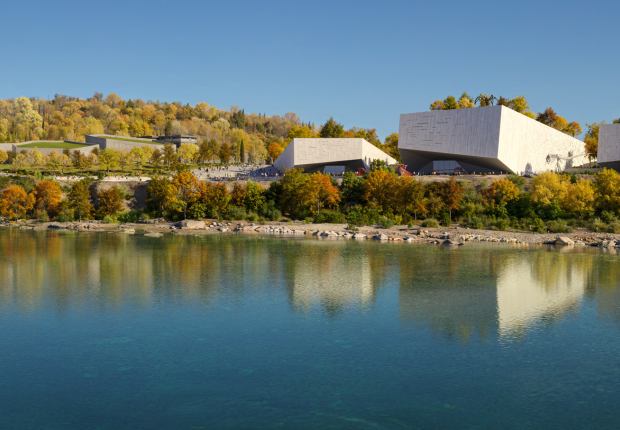The exhibition, curated by
Fernando Menis, features models and photographs, actual and historical, as well as videos that explain the project and its evolution. It can be visited until May 29, 2023, at the Parque del Drago Visitor Center, during its opening hours.
The Drago Tree of Icod de los Vinos, in Tenerife, is the oldest specimen of Dracaena Drago in the Atlantic archipelago, a tree 16 m high with a 20 m circumference at the base. An endemic species of the Canary Islands with a slow growth, this species is a symbolic since it is considered the protector of the islands, but, at the beginning of the 1980s, the one that needed protection was precisely the drago tree.
 "El Parque del Drago, 1998-2023: 25 años envolviendo el árbol milenario" by Fernando Menis. Photograph by Hisao Suzuki.
"El Parque del Drago, 1998-2023: 25 años envolviendo el árbol milenario" by Fernando Menis. Photograph by Hisao Suzuki.
Visitors - about 1 million a year - flocked to visit it, and the intense activity that tourism brought around it put its life in danger. It was necessary to stop the visits and find solutions so that the drago tree did not die of success.
When scientific congresses had already begun discussing "biodiversity" and "renaturation of urban environments", but they were not yet mainstream concepts, the entry by a team of three young architects - Felipe Artengo,
Fernando Martín Menis and José María Rodríguez Pastrana - proposed a slow process of ecological restoration and won the international public design competition called by the authorities as requested by a number of biologists and botanists concerned about the health of the drago tree. What happened next is that the Parque del Drago has become one of the most important interventions in the Canary Islands in terms of biodiversity conservation and restoration of an area, a ravine in this case.
 "El Parque del Drago, 1998-2023: 25 años envolviendo el árbol milenario" by Fernando Menis. Photograph by Arvid Berg.
"El Parque del Drago, 1998-2023: 25 años envolviendo el árbol milenario" by Fernando Menis. Photograph by Arvid Berg.
Twenty-five years have gone since the drago tree and its new park have started to be visited again in 1998. Even more time has passed since the process of restoring the natural conditions of this mythical tree, which was in danger at the dawn of democracy in Spain, began.
"In 1984, we won an international public design competition for the Drago Tree Park to protect it from the hustle that had been progressively grown around this unique specimen. Although these 40 years have only been a moment for the millenary Drago Tree, for us they have translated into an ongoing architecture and landscaping project that has accompanied us throughout our career until now."
Fernando Menis, architect co-author of the project Parque del Drago.
 "El Parque del Drago, 1998-2023: 25 años envolviendo el árbol milenario" by Fernando Menis. Photograph by Hisao Suzuki.
"El Parque del Drago, 1998-2023: 25 años envolviendo el árbol milenario" by Fernando Menis. Photograph by Hisao Suzuki.
The way in which this ecological restoration project was approached then, and is still being addressed, explains and connects with the "Islands of the World" research in which
Fernando Menis condenses his expertise of more than four decades in designing with nature. The Drago Tree Park project put nature, a unique tree, at the center.
Today this decision may seem like a decision full of common sense, but in the `80s when tourism in the Canary Islands was booming, the project was perceived as impossible and insane, since it proposed the removal of the road that passed nearby, an essential general route in the north of the island, very busy with locals and tourists.
The young team's redesign project removed the road to protect the drago tree from all kinds of pollution and vibrations, away from the noise and smoke of the city to return it to its original habitat, as it was the way it had grown for centuries, protected by a wall that separated a farm from the town of Icod de los Vinos. This fence, which was no longer there, was recreated by raising a wall again, located in the same place, with the same height and made with the same material, that is, local basalt stone.
 "El Parque del Drago, 1998-2023: 25 años envolviendo el árbol milenario" by Fernando Menis. Photograph by Hisao Suzuki.
"El Parque del Drago, 1998-2023: 25 años envolviendo el árbol milenario" by Fernando Menis. Photograph by Hisao Suzuki.
On the other hand, the perimeter of the old farm, the last one between the town and the ravine, was fenced off again as always to protect the tree that grew on the edge of the ravine, living for hundreds of years in the original environment, a natural paradise from which it was expelled, forcing its introduction into the urban center and on the island's tourist routes.
Work is currently underway to complete the Visitor Center, a building designed by the same architects and the reason for a new legal controversy in 2023, the last of the many vicissitudes that El Parque del Drago has been enduring.
The "Islands of the World" initiative is supported by Canarias Aporta, Proexca, Fundación CajaCanarias, Cabildo de Tenerife, Ministry of Culture and Sports of the Government of the Canary Islands, ICEX Next, Turismo de Canarias and the Canarian Institute for Cultural Development.























































































